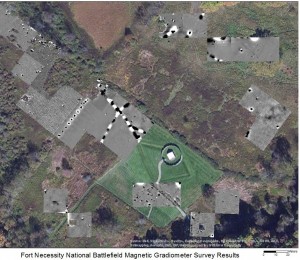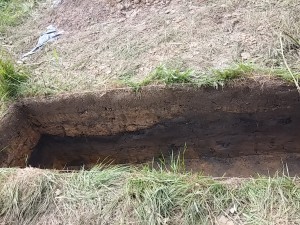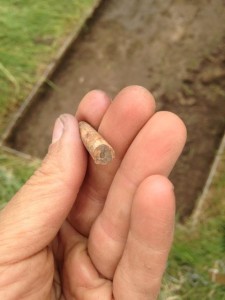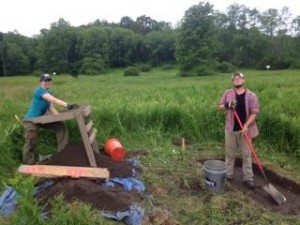
Fort Necessity 2016 field crew. L to R: Mike White head (supervisor), Eden VanTries, James Miller, Hannah Harvey, Samantha Jacobs, Dwayne Santella (Cal U), and Cheryl Frankum.
This week we will finish excavations at Fort Necessity National Battlefield. It’s been a good seven weeks, but all good things must come to an end. This is actually our second season at Fort Necessity. Last summer we conducted a large-scale geophysical survey using ground-penetrating radar, gradiometry, and resistivity. This summer we tested more than thirty geophysical anomalies, as well as completed a shovel test pit and metal detecting survey. We’ll be back out at the site in August to do another metal detecting survey as part of a class taught by Advanced Metal Detecting for the Archaeologist (check back later in the summer for more on that). All of this work is funded by a grant from the National Park Service (NPS) through the Cooperative Ecosystem Study Units Network.

Gradiometer results from the 2015 geophysical survey at Fort Necessity National Battlefield. The the fort itself, with its earthworks, palisade, and storehouse, is situated near the center of the image.
The Fort Necessity partnership between IUP and NPS has the dual goals of providing good real-world experience for archaeology students while providing the park with high quality research that will help them interpret and manage this nationally significant cultural resource. For those of you not familiar with Fort Necessity, it is the most recognizable landmark from a young George Washington’s foray into western Pennsylvania, during which he helped touch off the French and Indian War, and by extension the Seven Years War, which is arguably the first world war…kind of a big deal. But back to the project goals – this has certainly been a great opportunity for students. A total of 11 graduate and undergraduate students have honed their archaeological skills over the past two years, while making some money, and living in exotic Uniontown. For some of these students this is their first taste of CRM life and nearly all of them have loved it.
We’ve also fulfilled our objective of providing the park with updated archaeological data. We’ve been able to identify nearly all of the geophysical anomalies. Most of the features date to after the George Washington period, however. Much of what we’ve found relates to the roughly two centuries between the battle and the establishment of the park. We’ve uncovered field drains, old roads, reenactor campfires, and fill episodes. But there have been highlights as well. Near the fort we uncovered a buried A horizon containing 18th century artifacts. We’ve also uncovered pieces of shot that may help us reconstruct the battle and several artifacts that date to the time of the fort. And we’ve still got a week to go.
If you are in Fayette County next week, stop by and see us.


